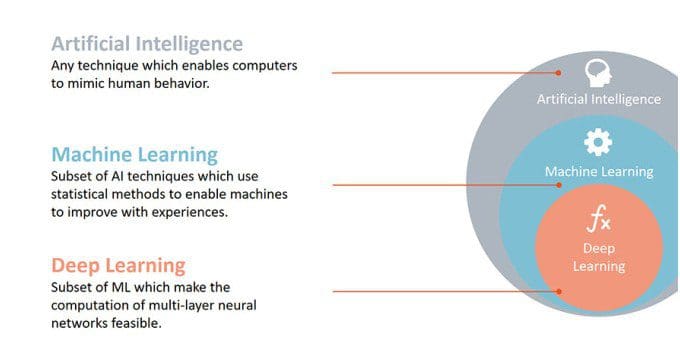 What Are Artificial Intelligence, Machine Learning, and Deep Learning?
What Are Artificial Intelligence, Machine Learning, and Deep Learning?
AI and Machine Learning have become mainstream, and people know shockingly little about it. Here is an explainer and useful references.
By RapidMiner. Sponsored Post.
There is hardly a day where we don’t see any news on artificial intelligence in the media. Below is a short collection of some recent news headlines:
- Artificial Intelligence Comes to Hollywood – Is your job safe?
- This robot explains why you shouldn’t worry about artificial intelligence– yes, that’s right. A talking robot is surely doing the trick of NOT freaking out the nay-sayers even more…
- How artificial intelligence learns to be racist– simple: it’s mimicking us…
- How Artificial Intelligence Might Transform the Engineering Industry
It is interesting that most of these articles have a skeptical, if not negative tone. This sentiment is also fueled with statements made by Bill Gates, Elon Musk, and even Stephen Hawking. With all due respect, I would not stand in public talking nonsense about wormholes, so maybe we all should focus a bit more on our areas of expertise.
This all underlines two things: 1. artificial intelligence and machine learning have finally become mainstream, and 2. people know shockingly little about it.
There is also a high dose of hype around these topics. We’ve all heard about “Linear Regression” before. This should not come as a surprise since it was invented more than 200 years ago by Legendre and Gauss. Still, this overdose of hype can lead to situations where people get carried away whenever they use this method. Here is one of my favorite tweet exchanges which exemplifies this:
@katherinebailey Because marketing? Everytime someone calls simple linear regression “AI” Gauss turns over in his grave.
— RapidMiner (@RapidMiner) April 15, 2017
Evidently there is high level of confusion around these terms. This post should help you understand the differences between these fields as well as their relationships to each other. Let’s get started with the picture below. It explains the three terms: artificial intelligence, machine learning, and deep learning.
Artificial Intelligence covers anything which enables computers to behave like humans. Think of the famous (although a bit outdated) Turing test to determine if this is the case or not. If you talk to Siri on your phone and get an answer, you’re already close. Automatic trading systems using machine learning to be more adaptive would already fall into this category as well.
Machine Learning is the subset of Artificial Intelligence that deals with the extraction of patterns from data sets. This means that the machine can find rules for optimal behavior but also can adapt to changes in the world. Many of the algorithms involved have been known for decades, centuries, even. Thanks to the advances in computer science and parallel computing they can now scale up to massive data volumes.
Deep Learning is a specific class of Machine Learning algorithms which use complex neural networks. In a sense, it is a group of related techniques comparable to a group of “decision trees” or “support vector machines”. But thanks to advances in parallel computing they’ve received quite a bit of hype recently, which is why I broke them out here. As you can see, Deep Learning is a subset of methods from Machine Learning. When somebody explains that Deep Learning is “radically different from Machine Learning“, they are wrong. If you would like to get a BS-free view on Deep Learning, check out this webinar I did some time ago.
But if Machine Learning is only a subset of Artificial Intelligence, what else is a part of this field? Below is a summary of the most important research areas and methods for each of the three groups:
- Artificial Intelligence: Machine Learning (duh!), natural language understanding, language synthesis, computer vision, robotics, sensor analysis, optimization & simulation, and more.
- Machine Learning: Deep Learning (another duh!), support vector machines, decision trees, Bayes learning, k-means clustering, association rule learning, regression, and many more.
- Deep Learning: Artificial neural networks, convolutional neural networks, recursive neural networks, long short-term memory, deep belief networks, and many more.
As you can see, there are dozens of techniques in each of these fields, and researchers generate new algorithms on a weekly basis. Although those algorithms might be complex, the conceptual differences as explained above are not.
We hope this has been useful in helping you differentiate between these terms. If you’re interested in learning more about Machine Learning, check out this whitepaper on How to Correctly Validate Machine Learning Models.

 What Are Artificial Intelligence, Machine Learning, and Deep Learning?
What Are Artificial Intelligence, Machine Learning, and Deep Learning?